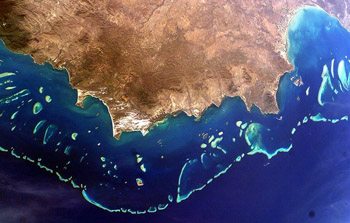Here’s a question for you: how much of a masterpiece can you remove, before it loses its value and beauty for which it is recognised? That’s the question the Australian government is wrestling with as the coal industry makes greater and greater inroads into the masterpiece that is the Great Barrier Reef.
Three coal companies and their Queensland Government facilitators, North Queensland Bulk Ports, have released a Cumulative Impact Assessment of their proposals to build three new coal terminals at Abbot Point, on the Great Barrier Reef coast, along with two rail loops and several million cubic metres of dredging. The assessment describes the waters around Abbot Point – waters that are inhabited by five species of marine turtle, Humpback whales that rest there on their annual migration, and dugongs that feed on the seagrass meadows around the Point and also includes the internationally significant wetland that hosts migratory shorebirds from the other side of the world.
In order to build three large new coal terminals at this place, and dredge the sea floor to make way for it, North Queensland Bulk Ports, Adani Enterprises, Hancock Coal and the BHPB-Mitsubishi Alliance had to get around the fact that Abbot Point and its wildlife are part of Australia’s largest and best known World Heritage Area. Here’s how they did it.
The Cumulative Impact Assessment makes the cunning argument that although turtles, dugongs, whales, and birds all live at or visit Abbot Point, each of them is “represented in a way which contributes to overall GBRWHA scenic diversity; but not outstanding per se nor uniquely expressed at Abbot Point.”
Take one of Monet’s water lilies. Zoom in. Find a square inch that doesn’t look particularly spectacular at close range. Say to yourself, “This square of canvas is just a grey splodge: it’s not a unique expression of the beauty of this masterpiece, nor is it outstanding, per se. So, cut out that square inch with a knife, since it is not so very important. You will have ruined something of great beauty and value and something that you can never repair. This is not just vandalism; it is a failure of the imagination that future generations will never forgive.
Nevertheless this is the illusion the coal industry plays on Australia when they ask us to look just at one small part of the Great Barrier Reef and say “is this worth preventing us spending money? Of course not! Let us through.”
Three weeks ago, the Federal Environment Minister gave approval to build one of the coal terminals that was subject of this assessment – Hancock Coal’s “T3” terminal. In the days prior to that approval being made public, Greenpeace obtained through Right to Information law the results of the migratory and threatened bird surveys conducted at Abbot Point for the Cumulative Impact Assessment. We revealed that there was substantial information about the ecological value of the Caley Valley Wetlands at Abbot Point that was collected for this study but not included in the statutory assessment process conducted for that coal terminal.
The Federal Government seems strangely unconcerned that their assessment process has been exposed as being so useless. The surveys for the Abbot Point Cumulative Impact Assessment revealed that the Caley Valley Wetlands are habitat for a nationally important population of the threatened Australian painted snipe. The assessment documents for Alpha and the T3 coal terminal both said that there was no record of this species there. How could they get it so wrong?
Tony Burke himself said back in June “We’re talking about the Reef. If you can’t get your environmental protections and systems in place on this one you may as well give up.” Is that what he’s now done?
The coal industry is asking Australia to accept dangerous climate change and the death of the Great Barrier Reef as an acceptable cost of its business agenda. Australians should not be asked to choose between protecting the Reef, tackling climate change, and providing sustainable jobs. In truth, we can have jobs and a healthy Reef without coal, but we can’t have a healthy Reef if we continue to develop its coast for coal.










